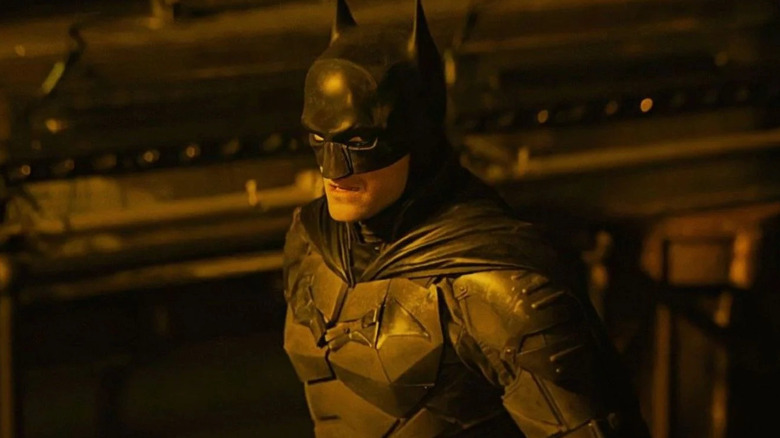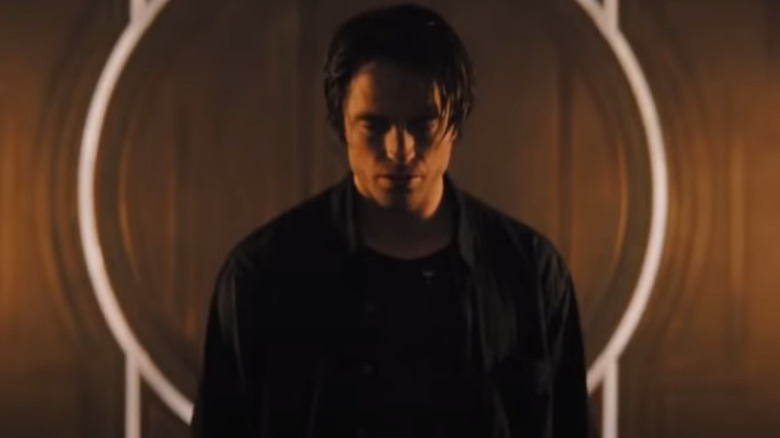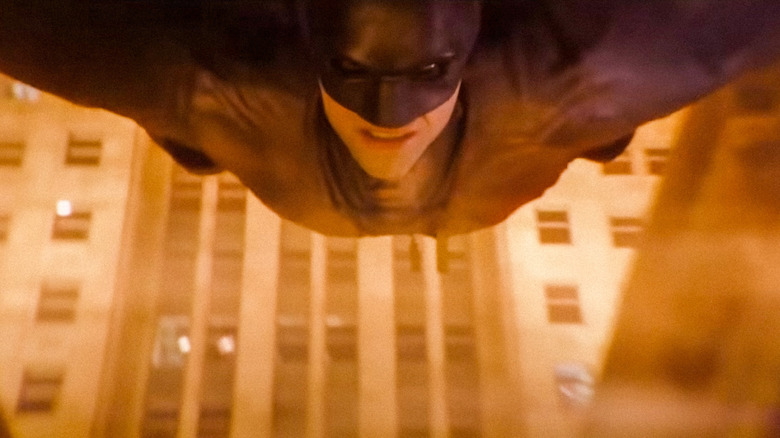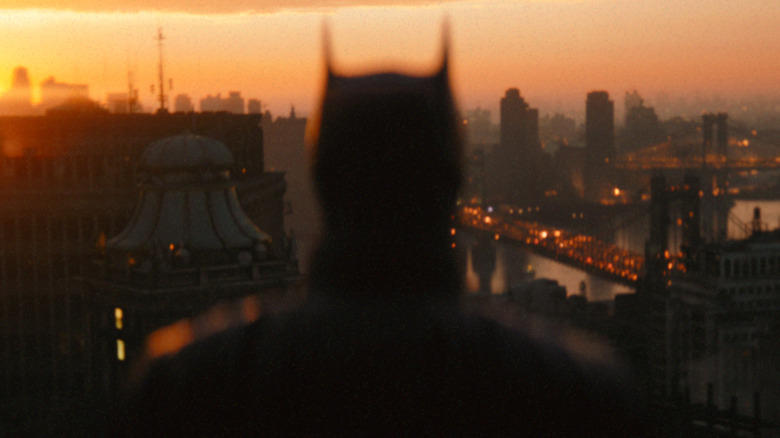Let's Talk About The Best Shot In The Batman

Warning: spoilers ahead for "The Batman."
Matt Reeves' "The Batman" is finally here, and the noir-influenced superhero entry shines a new light on many aspects of the Caped Crusader that we haven't seen before. It's a sprawling, complex look into both Batman's earlier years and the emerging coterie of larger-than-life villains that come to dominate his crimefighting career. With such a deep look into the heart of Gotham's corruption and growing malaise, one might expect to merely find bleak landscapes enveloped in humdrum darkness. But DP (director of photography) Greig Fraser punctuates the bleakness with bursts of light, finds richness in the textures of the rain-soaked city, and uses the lens skillfully to compliment the script and Pattinson's performance, giving us a window into the subjectivity of The Bat.
There are a number of incredible shots in "The Batman," and if we were to explore them all this article would be as long as the film. The Batmobile bursting out of the flames to startle The Penguin. The upside-down shot showcasing the Penguin being literally upended in the aftermath of the chase. The club fight, the rooftop Catwoman rendezvous, the Third Act flare-lit rescue ... it's a gorgeous film. Yet one shot in particular stands out for its skillful execution, contribution to the film's themes, and ability to wordlessly give us a look into Bruce Wayne's complexities as both as both the man and The Bat. Let's take a moment to discuss that epic wingsuit escape.
Getting Behind The Cowl

A film's cinematography is responsible for everything from the composition of its images to carrying delicate details to the viewer and much, much more. One major aspect of carrying those details is its ability to capture a character's subjectivity onscreen. A great DP finds subtle ways to wordlessly translate a character's inner thoughts and feelings to an audience.
With "The Batman" being so focused on Bruce Wayne's earlier crime fighting career, capturing the Dark Knight's evolution -- and with it, the subjective experience that drives and evolves him -- is key. Capturing point-of-view was pivotal for Matt Reeves, as he discussed regarding the now-famous upside-down Penguin shot:
"I'm into this very Hitchcockian point of view — putting the camera in the subjective point of view of the character. So you can put the audience into that experience. So I thought it would be great if, at the end of all this propulsive, 'French Connection' sort of craziness, to suddenly be in the Penguin's point of view as he's lying upside down as you have this sort of mythic appearance of Batman with fire raging behind him."
With Reeves' focus on capturing characters' subjectivity, DP Greig Fraser employed techniques to highlight the characters' subjective experiences (and particularly that of the gent in the Batsuit). This includes the use of Arri Alexa LF anamorphic lenses, whose soft bokeh effect allows him to keep the foreground characters clear while the background becomes blurred and obscured. Fraser frequently shoots characters in centered close up, background obscured, to lock us into their perspective and let that dominate the frame. Nowhere is that more prevalent than in the wonderful wingsuit shot.
The Best Shot In The Batman

The funeral scene in "The Batman" sets up a unique challenge for the Caped Crusader. D.A. Gil Colson (Peter Sarsgaard), captured by the Riddler, was sent in a vehicle to plow into the funeral with a message (and a phone) for the Batman. Colson's given a challenge by the Riddler to answer three riddles in two minutes for the code to a collar bomb. It's rigged -- The Riddler really just wants to deliver a message to Batman and keeps Colson talking until time runs out. A huge explosion knocks Batman out, and he wakes up in police custody.
Here's the thing about vigilantes in police custody: they don't want to stay there, especially in a corrupt department. Lt. James Gordon conspires with Batman and takes a punch, allowing the latter to escape to the police department roof. Batman emerges and, seeing how high he is, stops nervously at the edge. He grimaces, but has enough time to deploy his wingsuit, setting off to glide down and away from the police department roof at the last second. Here's where the best shot in "The Batman" comes in.
His quick descent is shot in a back-and-forth alternation between a close, subjective shot of his determined face reacting to the frightening descent, interspersed with brief shots of his actual glide through the city and subjective shots where we can look through his eyes. The glide ends when Batman triggers a parachute that hits an overpass, sending him tumbling painfully to the ground. There's just enough view of the glide for context, but the focus is very much on his subjective reaction to the glide -- determined, grit-teeth, uneasy, and slightly afraid. (It's worth noting that he later chose to rappel after Catwoman to keep her from killing Falcone despite gliding being a faster choice ... he really must have disliked the journey, and it shows). Its a gorgeous shot that puts us into Batman's head with no words whatsoever.
Why The Wingsuit Shot Is The Best

There are many aspects of that epic glide shot that really land, and which make it the best shot of such an overall lovely film. We're used to seeing the experienced Batman, long practiced and comfortable with an array of advanced technologies. This is a Batman who is still developing, growing, evolving. He's doing things he isn't comfortable with because he has to; it's just a job that needs to be done, risks and all. This shot wordlessly captures Bruce Wayne-the-man, moving from his evident fear to his determined grimace while using a death-defying technology, interspersed with shots that see directly through his eyes.
The distance most prior films put the audience at sets us in awe at Batman, but also decidedly separated from him -- or, more accurately he's separated from us. Batman is Peak Human: brilliant, resourced, trained to the point of human perfection, and that's how he's most often shot. Here, he's vulnerable. Afraid. Gritting his teeth through a dangerous stunt. For once we can see the man behind the Bat, and it's further enhanced by shots that show the glide through his eyes.
Together these shots bring us closer into Batman's perspective than any film ever has. Fraser's shots in this sequence expose us to his emotions, take us behind his eyes, and give us a glimpse behind the veneer of the Caped Crusader. Reeves' purpose in "The Batman" is to take us deeper into Bruce Wayne and his crimefighting struggles, and Fraser really lands that throughout with smart camera work. Nowhere is it better accomplished than this incredible, high-octane shot.
"The Batman" is in theaters now.
Read this next: The 11 Coolest Easter Eggs In The Batman
The post Let's Talk About the Best Shot in The Batman appeared first on /Film.
from /Film https://ift.tt/65dDzQt
No comments: